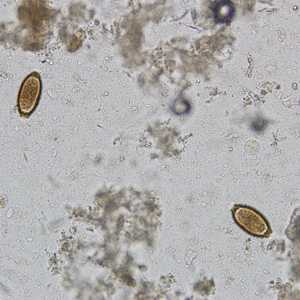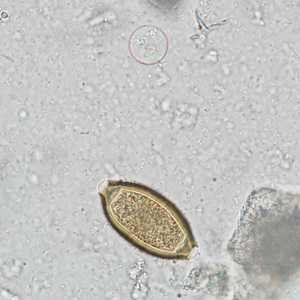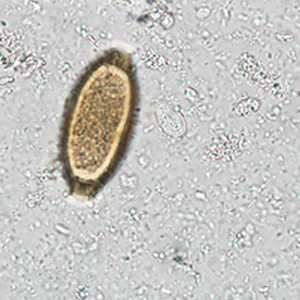
Case #242 - December, 2008
A nine-year-old boy from Central America, who had recently immigrated to the United States with his family, was taken to a local health facility with complaints of intestinal cramping and intermittent diarrhea. A stool specimen was obtained for ova and parasite (O&P) testing. A formalin-ethyl acetate (FEA) concentration was performed. The following figures show what was observed on a wet mount prepared from the concentrate. Figure A was taken at 100x magnification; Figures B–D at 400x magnification (Figures B and C are of the same field but in different planes of focus). The large objects of interest measured approximately 52 micrometers in length by 22 micrometers in width. What is your diagnosis? Based on what criteria?

Figure A

Figure B

Figure C

Figure D
Case Answer
This was a case of trichuriasis caused by Trichuris trichiura, the human whipworm. Also observed was Entamoeba coli. Diagnostic features included:
Trichuris trichiura:
- barrel-shaped, unembryonated, thick shelled eggs with polar prominences.
- eggs within the size range (50-55 micrometers) for the species.
Entamoeba coli:
- a round cyst containing more than four nuclei.
Also present in Figures A and D was a cyst of Giardia duodenalis, although the images did not clearly show the diagnostic features needed to confirm this species. The main objective of this case was to demonstrate the ability to detect protozoa simultaneously with helminth eggs at 200x magnification, and to show that more than one species of parasite are often present when the source of infection is fecal-contaminated food or water.
More on: Trichuriasis
More on: Giardiasis
More on: Nonpathogenic Amoebae
Images presented in the monthly case studies are from specimens submitted for diagnosis or archiving. On rare occasions, clinical histories given may be partly fictitious.
DPDx is an education resource designed for health professionals and laboratory scientists. For an overview including prevention and control visit www.cdc.gov/parasites/.
- Page last reviewed: August 24, 2016
- Page last updated: August 24, 2016
- Content source:
- Global Health – Division of Parasitic Diseases and Malaria
- Notice: Linking to a non-federal site does not constitute an endorsement by HHS, CDC or any of its employees of the sponsors or the information and products presented on the site.
- Maintained By:


 ShareCompartir
ShareCompartir